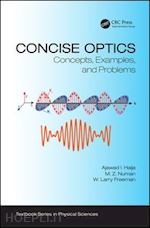Ajawad I. Haija attended the University of Alexandria in Egypt, where he received his B.Sc. degree in 1968 with distinction, first honor. He received his Ph.D. (1971-1977) at Pennsylvania State University in 1977. In 2000, he moved to the United States and joined the Indiana University of Pennsylvania. He is currently on the physics faculty, where he conducts research on the properties of thin multilayer structures and super-lattices. In 2014 Dr. Haija was awarded the Distinguished Faculty Award for Teaching, 2013–2014, Indiana University of Pennsylvania, IUP. A. J. Haija is a former member of New York Academy of Sciences and a current member of the American Physical Society. M. Z. Numan hails from Bangladesh, where he received his B.Sc. (Hons.) and M.Sc. degrees in physics from Dhaka University. He received his Ph.D. from The College of William and Mary in Virginia in 1982. He taught at Virginia Commonwealth University in Richmond, Virginia, University of North Carolina at Chapel Hill, and Indiana University of Pennsylvania, where he is currently the chair of the department of physics. His research focused on materials modification and characterization using ion implantation, back scattering and channeling; optical and electrical characterization of metallic multi-layers and semiconductor materials; light harvesting through silicon micro and nano structures. W. Larry Freeman was born and grew up in South Carolina, USA, and earned his B.Sc. in physics from Appalachian State University in 1969. Dr. Freeman received his Ph.D. From Clemson University in 1976 where his dissertation explored quantum size effects in thin Bismuth films at low temperatures. After leaving Clemson University and teaching high school and technical college, he returned to Clemson on a post-doctoral position. He joined the US Naval Intelligence service in 1978, and was moved to the US Army Night Vision and Electro-Optics Laboratory in 1980 where he was heavily involved with the development of solid-state materials used for the detection of radiation in the infrared radiation wavelength range. He was instrumental in developing nondestructive testing and characterization as well as fabrication techniques for the manufacturing of solid-state infrared detector arrays. Dr. Freeman moved to Indiana University of Pennsylvania in 1984 where he taught graduate and undergraduate courses in physics. He retired from IUP in 2010 and currently holds the position of Emeritus Professor of Physics. He maintains his memberships in the American Physical Society and American Association of Physics Teachers.











